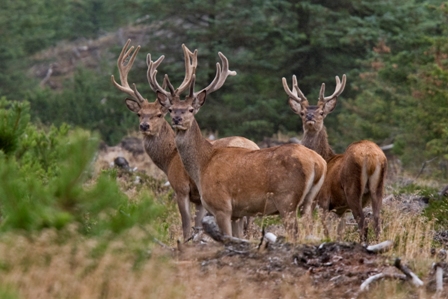Changed hunting seasons have only minor effects on hunters’ harvest size
The hunters’ total number of game bagged is only marginally influenced by changes in hunting season length, even if the season is shortened when used as a population management tool.

This is shown in an analysis covering 50 years of changes in hunting season length compared with national annual bag size during the same period.
The analysis was undertaken by senior scientist Peter Sunde and senior biologist Tommy Asferg, Aarhus University, as part of DCE's research-based consultancy service to the Nature Agency and Vildtforvaltningsrådet (the game management council). With the title ‘How does harvest size vary with hunting season length?’ the analysis has now been published in the online journal Wildlife Biology.
The hunting season is the period when hunting on a number of Denmark's wild animal and bird species is allowed. Until the 2014-15 hunting season, a hunting season was specified for ten mammal and 33 bird species, typically lasting from September to January inclusive.
In the analysis, the researchers focused on 63 changes in hunting season duration over the period 1957-2007 involving 28 species and the bag size reported to the Danish game statistics during the 50-year period. The analysis shows that the changes generally have had a minimal impact on hunters’ harvests, not least on the sedentary, i.e. non-migratory, wildlife species.
An explanation for the lack of decline in hunters' harvests following a shortened hunting season may be that the individual hunter has a ‘fixed’ aim for his harvest of a specific species within a given season irrespective of its length, say the researchers in their analysis.
"Historically, changes in hunting season length have been used as a tool to decrease or increase the hunting pressure on game populations. How well the tool works has never been known," says senior scientist Peter Sunde and continues:
"Having analysed the effect of the 63 changes in hunting season length, we conclude that the effect generally is insignificant, if even existing. Probably this is because the Danish hunting seasons generally are sufficiently long to allow the hunters to compensate for any limitations in the total hunting season length by concentrating their efforts in the remaining season; vice versa, their total hunting efforts do not change significantly if hunting seasons are prolonged."
Peter Sunde and Tommy Asferg conclude that unless you have a special reason to believe that hunters’ efforts are limited by the total length of the hunting season, you should not expect changes in hunting season length to have any demonstrable impact on the number of animals shot.
For the same reason, manipulation of hunting season length is generally inefficient as a means to obtain changes in the hunting pressure on a species, the two researchers say.
Contact: Senior scientist Peter Sunde, tel. +45 8715 8884/-45 20630704, psu@dmu.dk
Senior biologist Tommy Asferg, tel. +45 8715 8869, ta@dmu.dk
DCE – Danish Centre for Environment and Energy
Department of Bioscience, Aarhus University
How does harvest size vary with hunting season length? Peter Sunde & Tommy Asferg. Wildlife Biology.
